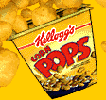
Chicago Board of Trade

Chicago, Illinois, provides a central market for the trading of agricultural resouces. Corn, soy beans, wheat, and oats are traded at the Chicago Board of Trade; milk, butter, pork bellies, live cattle, and feeder cattle are traded at the Chicago Mercantile Exchange. The actual items are not traded on the floor. The traders are buying and selling futures contracts. A futures contract is a standardized agreement to buy or sell a commodity at a date in the future. The contract specifies:
The price of commodities varies greatly week to week, day to day, hour to hour.
| Go to the Final Settlement Report from the Chicago Board of Trade. Print out a copy. Look at the table for corn. Subtract the numbers in the "settle" column from those in the "opening" column. Do your answers match the numbers in the "net chg" (change) column? They should. What do you think the numbers in the other columns represent? |
| Pretend you are a farmer. You planted corn in the spring. It is now July and you realize that you are going to have much more corn than anticipated. What will you do with all of that corn? Why not make a profit - sell it! Unfortunately harvest time is not until October. The current price of a bushel of corn is high; you will make an excellent profit if you sell the corn at that price. Will the price still be high in October? A futures contract will eliminate uncertainty. By placing an order with the trader on the floor of the Board of Trade you secure the current price for your corn. When October comes the price of corn drops but you need not to worry. Through the commodities market you secured that high price. Congratulations! Now what are you going to do with all of that money? |  |
| Listen to what Ron Orsborn has to say about farm profit. |
| One feeder cattle futures contract is for a total of 50,000 pounds to be filled by 700 to 799 pound feeder steer. Pretend all cattle weigh 750 pounds each. How many steer are included in a contract? What type of farm might these cattle come from? |
| Cargill is an example of vertically intergrated business. Cargill produces and packages beef under the name Excel. Cargill has its own traders on the Mercantile Exchange and Board of Trade who sell the meat and aquire feed necessary for beef production. Visit the Cargill website. Compare and contrast this form of agriculture to that of family farming. |
 Milk sells for $1.95 per gallon retail. The farmer received $1.13. |
 The farmer received 4 cents for the corn used to make this cereal. |
 Bread sells for $1.50 lb retail. The farmer received 5 cents for the wheat used in this loaf. |
Approximate prices for September 1994

